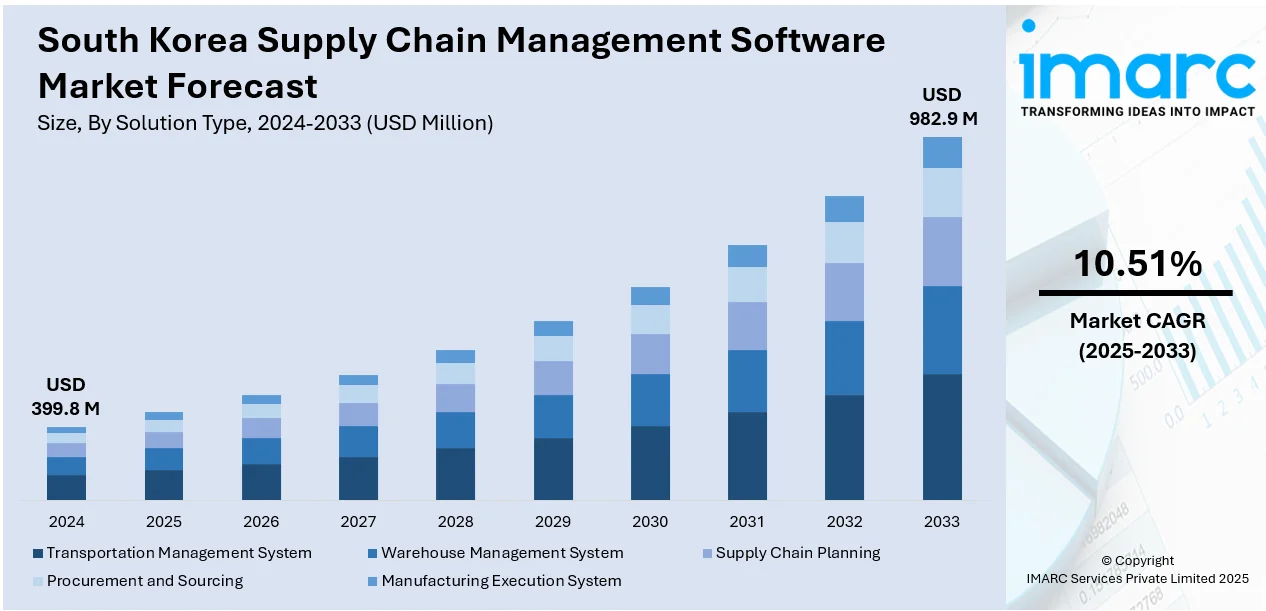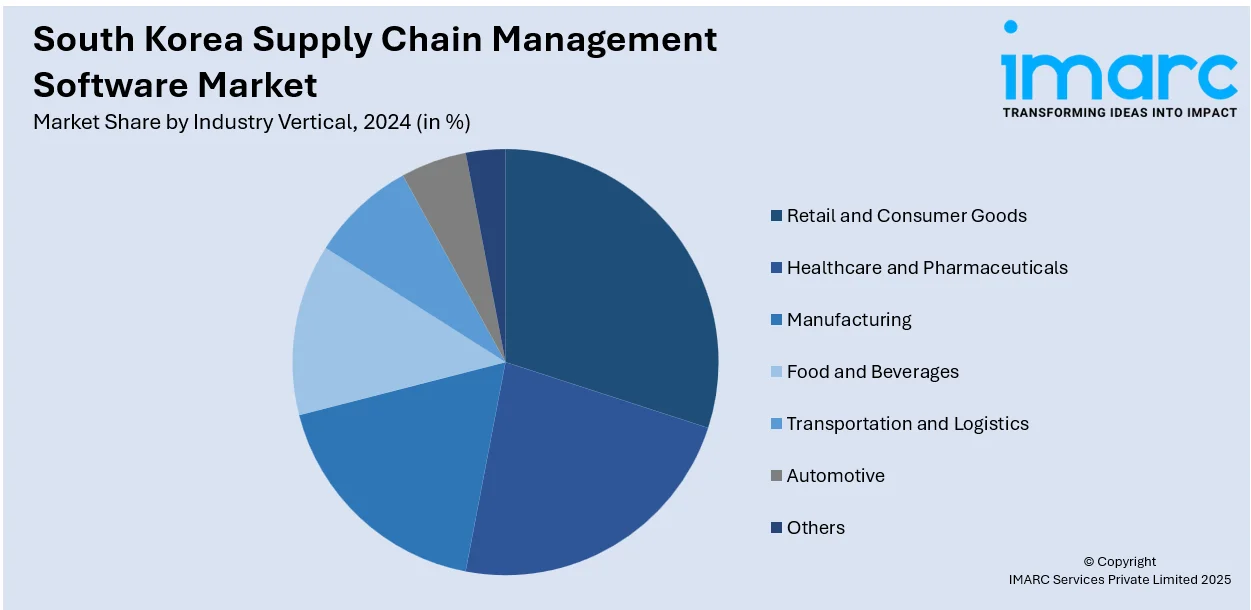
South Korea Supply Chain Management Software Market Size, Share, Trends and Forecast by Solution Type, Deployment Mode, Organization Size, Industry Vertical, and Region, 2025-2033
South Korea Supply Chain Management Software Market Overview:
The South Korea supply chain management software market size reached USD 399.8 Million in 2024. The market is projected to reach USD 982.9 Million by 2033, exhibiting a growth rate (CAGR) of 10.51% during 2025-2033. At present, the expansion of e-commerce portals is creating the need for fast, flexible, and efficient logistics operations. Besides this, rising integration of the Internet of Things (IoT), which is facilitating real-time tracking, smarter inventory control, and better decision-making across the supply chain, is fueling the South Korea supply chain management software market share.
|
Report Attribute
|
Key Statistics
|
|---|---|
|
Base Year
|
2024
|
|
Forecast Years
|
2025-2033
|
|
Historical Years
|
2019-2024
|
| Market Size in 2024 | USD 399.8 Million |
| Market Forecast in 2033 | USD 982.9 Million |
| Market Growth Rate 2025-2033 | 10.51% |
South Korea Supply Chain Management Software Market Trends:
Expansion of e-commerce portals
The expansion of e-commerce portals is fueling the market growth. As per the IMARC Group, the South Korea e-commerce market size reached USD 510 Billion in 2024. As more people are shopping online for everything, ranging from electronics to groceries, businesses must manage higher volumes of orders, faster delivery expectations, and more complex inventory demands. Supply chain management software helps companies streamline these processes by providing real-time tracking, automated inventory updates, and efficient order fulfillment systems. In South Korea, where digital adoption is high and online shopping is a major trend, e-commerce companies continue to rely on supply chain management solutions to stay competitive and meet customer demands. The software enables better coordination between suppliers, warehouses, delivery services, and retailers, reducing errors and delays. It also aids businesses in handling seasonal spikes, managing returns, and maintaining accurate stock levels across multiple platforms. As same-day and next-day delivery are becoming more common, the need for precise and responsive supply chain operations is growing. Supply chain management software also offers valuable insights through data analytics, helping businesses forecast demand and optimize routes. With the rapid broadening of e-commerce in urban and rural areas alike, companies of all sizes are adopting supply chain management tools to enhance efficiency, decrease costs, and improve customer satisfaction.

To get more information on this market, Request Sample
Increasing utilization of IoT
Rising IoT integration is propelling the South Korea supply chain management software market growth. As per the ‘Digital Economy Outlook (DEO) 2024 Volume 1' report published by the OECD, Korean firms demonstrated remarkable success in embracing digital technologies relative to other OECD countries, as of May 2024. Korea held the top position in IoT (53%) and big data analytics (40%) adoption rates. IoT devices, such as sensors and smart tags, provide constant updates on the location, condition, and movement of goods. This helps companies monitor shipments, reduce delays, and prevent losses. In South Korea, where technology adoption is high, manufacturers, retailers, and logistics providers continue to rely on IoT-enabled supply chain management software to enhance visibility and responsiveness. IoT data also aids in detecting issues like temperature changes and equipment failures, allowing timely interventions that protect product quality. Businesses use this data to enhance pathways, cut fuel expenses, and increase delivery efficiency. Assimilation of the IoT with supply chain management software also supports automation, such as restocking alerts and machine maintenance scheduling, boosting overall efficiency.
South Korea Supply Chain Management Software Market Segmentation:
IMARC Group provides an analysis of the key trends in each segment of the market, along with forecasts at the country and regional levels for 2025-2033. Our report has categorized the market based on solution type, deployment mode, organization size, and industry vertical.
Solution Type Insights:
- Transportation Management System
- Warehouse Management System
- Supply Chain Planning
- Procurement and Sourcing
- Manufacturing Execution System
The report has provided a detailed breakup and analysis of the market based on the solution type. This includes transportation management system, warehouse management system, supply chain planning, procurement and sourcing, and manufacturing execution system.
Deployment Mode Insights:
- On-premises
- Cloud-based
A detailed breakup and analysis of the market based on the deployment mode have also been provided in the report. This includes on-premises and cloud-based.
Organization size Insights:
- Small and Medium-sized Enterprises
- Large Enterprises
The report has provided a detailed breakup and analysis of the market based on the organization size. This includes small and medium-sized enterprises and large enterprises.
Industry Vertical Insights:

- Retail and Consumer Goods
- Healthcare and Pharmaceuticals
- Manufacturing
- Food and Beverages
- Transportation and Logistics
- Automotive
- Others
A detailed breakup and analysis of the market based on the industry vertical have also been provided in the report. This includes retail and consumer goods, healthcare and pharmaceuticals, manufacturing, food and beverages, transportation and logistics, automotive, and others.
Regional Insights:
- Seoul Capital Area
- Yeongnam (Southeastern Region)
- Honam (Southwestern Region)
- Hoseo (Central Region)
- Others
The report has also provided a comprehensive analysis of all the major regional markets, which include Seoul Capital Area, Yeongnam (Southeastern Region), Honam (Southwestern Region), Hoseo (Central Region), and others.
Competitive Landscape:
The market research report has also provided a comprehensive analysis of the competitive landscape. Competitive analysis such as market structure, key player positioning, top winning strategies, competitive dashboard, and company evaluation quadrant has been covered in the report. Also, detailed profiles of all major companies have been provided.
South Korea Supply Chain Management Software Market News:
- In July 2025, Arrow Electronics unveiled engineering solutions center to enhance technological innovations in India, South Korea, Southeast Asia, and Japan. Arrow's ESC provided extensive design engineering proficiency throughout all phases of the product development lifecycle. The resources included in-market knowledge, technical training, top-tier supply chain services, ready-to-use software, and component samples.
- In November 2024, Kaspersky broadened its ‘Global Transparency Initiative (GTI)’, inaugurating its 12th Transparency Center in Seoul, South Korea. The firm provided local stakeholders with unique access to the tools and insights necessary for securing their operations, minimizing risks associated with the ICT supply chain. It offered a framework for how an organization could adhere to the stringent security standards of supply chain management, including those outlined in the ICT software supply chain security guidelines endorsed by South Korea's Ministry of Science.
South Korea Supply Chain Management Software Market Report Coverage:
| Report Features | Details |
|---|---|
| Base Year of the Analysis | 2024 |
| Historical Period | 2019-2024 |
| Forecast Period | 2025-2033 |
| Units | Million USD |
| Scope of the Report |
Exploration of Historical Trends and Market Outlook, Industry Catalysts and Challenges, Segment-Wise Historical and Future Market Assessment:
|
| Solution Types Covered | Transportation Management System, Warehouse Management System, Supply Chain Planning, Procurement and Sourcing, Manufacturing Execution System |
| Deployment Modes Covered | On-premises, Cloud-based |
| Organization Sizes Covered | Small and Medium-sized Enterprises, Large Enterprises |
| Industry Verticals Covered | Retail and Consumer Goods, Healthcare and Pharmaceuticals, Manufacturing, Food and Beverages, Transportation and Logistics, Automotive, Others |
| Regions Covered | Seoul Capital Area, Yeongnam (Southeastern Region), Honam (Southwestern Region), Hoseo (Central Region), Others |
| Customization Scope | 10% Free Customization |
| Post-Sale Analyst Support | 10-12 Weeks |
| Delivery Format | PDF and Excel through Email (We can also provide the editable version of the report in PPT/Word format on special request) |
Key Questions Answered in This Report:
- How has the South Korea supply chain management software market performed so far and how will it perform in the coming years?
- What is the breakup of the South Korea supply chain management software market on the basis of solution type?
- What is the breakup of the South Korea supply chain management software market on the basis of deployment mode?
- What is the breakup of the South Korea supply chain management software market on the basis of organization size?
- What is the breakup of the South Korea supply chain management software market on the basis of industry vertical?
- What is the breakup of the South Korea supply chain management software market on the basis of region?
- What are the various stages in the value chain of the South Korea supply chain management software market?
- What are the key driving factors and challenges in the South Korea supply chain management software market?
- What is the structure of the South Korea supply chain management software market and who are the key players?
- What is the degree of competition in the South Korea supply chain management software market?
Key Benefits for Stakeholders:
- IMARC’s industry report offers a comprehensive quantitative analysis of various market segments, historical and current market trends, market forecasts, and dynamics of the South Korea supply chain management software market from 2019-2033.
- The research report provides the latest information on the market drivers, challenges, and opportunities in the South Korea supply chain management software market.
- Porter's five forces analysis assist stakeholders in assessing the impact of new entrants, competitive rivalry, supplier power, buyer power, and the threat of substitution. It helps stakeholders to analyze the level of competition within the South Korea supply chain management software industry and its attractiveness.
- Competitive landscape allows stakeholders to understand their competitive environment and provides an insight into the current positions of key players in the market.
Need more help?
- Speak to our experienced analysts for insights on the current market scenarios.
- Include additional segments and countries to customize the report as per your requirement.
- Gain an unparalleled competitive advantage in your domain by understanding how to utilize the report and positively impacting your operations and revenue.
- For further assistance, please connect with our analysts.
 Request Customization
Request Customization
 Speak to an Analyst
Speak to an Analyst
 Request Brochure
Request Brochure
 Inquire Before Buying
Inquire Before Buying




.webp)




.webp)












